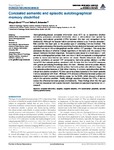Concealed semantic and episodic autobiographical memory electrified
| dc.contributor.author | Ganis, Giorgio | |
| dc.contributor.author | Schendan, Haline | |
| dc.date.accessioned | 2015-08-12T13:45:03Z | |
| dc.date.available | 2015-08-12T13:45:03Z | |
| dc.date.issued | 2013-01-24 | |
| dc.identifier.issn | 1662-5161 | |
| dc.identifier.issn | 1662-5161 | |
| dc.identifier.other | ARTN 354 | |
| dc.identifier.uri | http://hdl.handle.net/10026.1/3517 | |
| dc.description.abstract |
Electrophysiology-based concealed information tests (CIT) try to determine whether somebody possesses concealed information about a crime-related item (probe) by comparing event-related potentials (ERPs) between this item and comparison items (irrelevants). Although the broader field is sometimes referred to as "memory detection," little attention has been paid to the precise type of underlying memory involved. This study begins addressing this issue by examining the key distinction between semantic and episodic memory in the autobiographical domain within a CIT paradigm. This study also addresses the issue of whether multiple repetitions of the items over the course of the session habituate the brain responses. Participants were tested in a 3-stimulus CIT with semantic autobiographical probes (their own date of birth) and episodic autobiographical probes (a secret date learned just before the study). Results dissociated these two memory conditions on several ERP components. Semantic probes elicited a smaller frontal N2 than episodic probes, consistent with the idea that the frontal N2 decreases with greater pre-existing knowledge about the item. Likewise, semantic probes elicited a smaller central N400 than episodic probes. Semantic probes also elicited a larger P3b than episodic probes because of their richer meaning. In contrast, episodic probes elicited a larger late positive complex (LPC) than semantic probes, because of the recent episodic memory associated with them. All these ERPs showed a difference between probes and irrelevants in both memory conditions, except for the N400, which showed a difference only in the semantic condition. Finally, although repetition affected the ERPs, it did not reduce the difference between probes and irrelevants. These findings show that the type of memory associated with a probe has both theoretical and practical importance for CIT research. | |
| dc.format.extent | 354- | |
| dc.format.medium | Electronic-eCollection | |
| dc.language | eng | |
| dc.language.iso | en | |
| dc.publisher | Frontiers Media SA | |
| dc.subject | concealed information | |
| dc.subject | deception | |
| dc.subject | deception detection | |
| dc.subject | ERPs (event-related potentials) | |
| dc.subject | semantic memory | |
| dc.subject | episodic memory | |
| dc.title | Concealed semantic and episodic autobiographical memory electrified | |
| dc.type | journal-article | |
| dc.type | Article | |
| plymouth.author-url | https://www.webofscience.com/api/gateway?GWVersion=2&SrcApp=PARTNER_APP&SrcAuth=LinksAMR&KeyUT=WOS:000314169500001&DestLinkType=FullRecord&DestApp=ALL_WOS&UsrCustomerID=11bb513d99f797142bcfeffcc58ea008 | |
| plymouth.issue | DEC | |
| plymouth.volume | 6 | |
| plymouth.publication-status | Published | |
| plymouth.journal | Frontiers in Human Neuroscience | |
| dc.identifier.doi | 10.3389/fnhum.2012.00354 | |
| plymouth.organisational-group | /Plymouth | |
| plymouth.organisational-group | /Plymouth/Faculty of Health | |
| plymouth.organisational-group | /Plymouth/Faculty of Health/School of Psychology | |
| plymouth.organisational-group | /Plymouth/REF 2021 Researchers by UoA | |
| plymouth.organisational-group | /Plymouth/REF 2021 Researchers by UoA/UoA04 Psychology, Psychiatry and Neuroscience | |
| plymouth.organisational-group | /Plymouth/REF 2021 Researchers by UoA/UoA04 Psychology, Psychiatry and Neuroscience/UoA04 REF peer reviewers | |
| plymouth.organisational-group | /Plymouth/Research Groups | |
| plymouth.organisational-group | /Plymouth/Research Groups/Centre for Brain, Cognition and Behaviour (CBCB) | |
| plymouth.organisational-group | /Plymouth/Research Groups/Centre for Brain, Cognition and Behaviour (CBCB)/Brain | |
| plymouth.organisational-group | /Plymouth/Users by role | |
| plymouth.organisational-group | /Plymouth/Users by role/Academics | |
| dc.publisher.place | Switzerland | |
| dcterms.dateAccepted | 2012-12-20 | |
| dc.identifier.eissn | 1662-5161 | |
| dc.rights.embargoperiod | No embargo | |
| rioxxterms.versionofrecord | 10.3389/fnhum.2012.00354 | |
| rioxxterms.licenseref.uri | http://www.rioxx.net/licenses/all-rights-reserved | |
| rioxxterms.type | Journal Article/Review | |
| plymouth.oa-location | http://dx.doi.org/10.3389/fnhum.2012.00354 |


